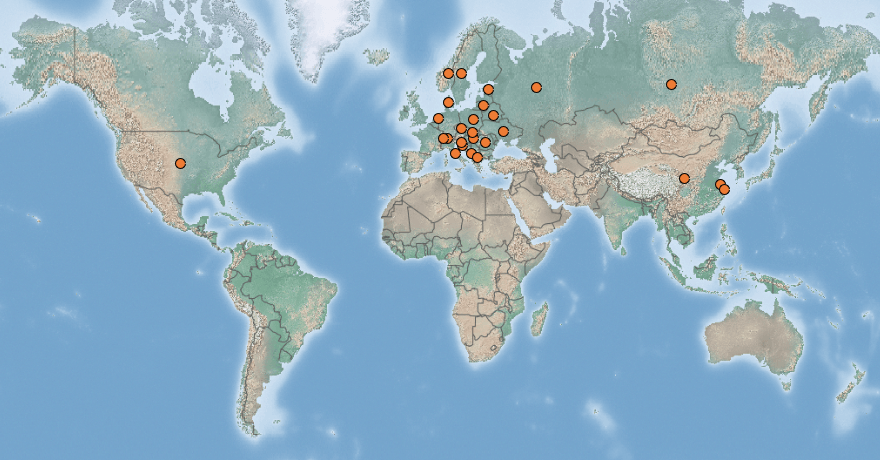 |
Tall fleabane | Status LU: established. 1st record: LU & ITW <1836. |
 |
Jäerlecht Beruffkraut | Status Eur.: established. 1st record: DK 1810. |
 |
Vergerette annuelle | RA: ISEIA: C1. Harmonia+: 0,03 |
 |
Feinstrahl | Wikipedia:     | Wikispecies: | Wikispecies:  | CABI | CABI |
 |
Zomerfijnstraal | Back to the list of neophytes |
Contents
Report the species
→ Report Erigeron annuus to the National Museum of Natural History.
Brief description
 Erigeron annuus (L.) Pers. is a North American plant that often populates ruderal sites. Because of its ability to form dense stands, the species can become problematic from a nature conservation point of view, if it enters established natural plant communities.
Erigeron annuus (L.) Pers. is a North American plant that often populates ruderal sites. Because of its ability to form dense stands, the species can become problematic from a nature conservation point of view, if it enters established natural plant communities.
Erigeron annuus is a highly variable species, in which American studies have distinguished several infraspecific taxa, generally with a more or less limited geographical distribution. Their application to naturalised populations in Europe has led to their being reported as two or even three distinct subspecies. In the environment two subspecies have often been distinguished: Erigeron annuus subsp. annuus and Erigeron annuus subsp. septentrionalis (Lambinon & Verloove 2012: 707-708).
Status and distribution in Luxembourg
Records of Erigeron annuus (L.) Pers. in Luxembourg. Data source: Recorder-Lux, iNaturalist & GBIF, 2024-10-22.
Tinant (1836: 428) indicates Erigeron annuus (L.) Pers. under its synonym Aster annuus L. on “the gravels of the banks of the Moselle near Remich”. Erigeron annuus was sampled on the edge of the Moselle river near Remich before 1842 (Holandre 1842: 336).1 The first edition of this flora from 1829 does not mention the species (Holandre 1829: 450). According to Lefort (1949: 46), Holandre’s “Flore de la Moselle” mentions Erigeron annuus near Schengen. It seems that all these refer to original material and observations of Tinant dating before 1836. An explanation of the confusion between Remich and Schengen as location may be read in the “Flore de Lorraine” by Grodron (1857: 387) who mentions Aster annuus L. at the “Banks of the Moselle near Remich, a little beyond the French border”2, which suggests the location of the finding by Tinant might have been closer to Schengen than to Remich. In 1873, Koltz lists the species under its synonyms Stenactis alba [in the text] and Aster stenactis [in the index] and confirms that it occurs on roadsides, in hedges, lawns, and at forest edges. “Remich. T. près Schengen (Hollandre)” (Koltz 1873: 129).
The next documented observation of the species in Luxembourg dates from 1953. Marcel Etringer collected a specimen of the species on a slag heap in Dommeldange on 15th September 1953 (Specimen № 48214, MNHNL 2000-). Nowadays Erigeron annuus is quite common to quite rare in the Lorraine district (AC-AR) and very rare (RR) or non-existent in the Ardennes district (Lambinon & Verloove 2012: 707).
Risk assessment
ISEIA protocol
C1 (2+2+1+1) (Ries et al. 2013: 18).
Harmonia+ protocol
Overall risk score 0,03 = (Overall Invasion score 0,28 x Overall Impact score 0,13) (Ries et al. 2020).
 Invasion
Invasion0,13

 Impact
Impact0,03

 Risk
RiskWorldwide distribution
Bibliography
- CABI, 2019. Erigeron annuus. In: Invasive Species Compendium. Wallingford, UK: CAB International. URL: www.cabi.org/isc [accessed 2020-03-02]
- Gordon, A., 1857. Flore de Lorraine. 504 p. 2e édition, tome 1. Nancy, Metz & Paris.
- Holandre, J.-J.-J., 1829. Flore de la Moselle, ou, Manuel d’herborisation, précédé d’un aperçu géologique sur le département et d’élémens abrégés de botanique. Tome 1. 712 p. Metz : Mme Thiel, libraire-éditeur.
- Holandre, J.-J.-J., 1842. Nouvelle flore de la Moselle, ou Manuel d’herborisation dans les environs de Metz principalement, et les autres parties du département. Tome 1 et 2, 948 p. Metz : Verronnais. Paris : Roret.
- Koltz, J.-P.-J., 1873. Prodrome de la flore du grand-duché de Luxembourg. Première partie. Plantes phanérogames. Imprimerie V. Buck, Luxembourg. 279 S.
- Lambinon J. & F. Verloove, 2012. Nouvelle flore de la Belgique, du grand-duché de Luxembourg, du Nord de la France et des régions voisines. Sixième édition. Avec la collaboration de L. Delvosalle, B. Toussaint, D. Geerinck, I. Hoste, F. Van Rossum, B. Cornier, R. Schumacker, A. Vanderpoorten et H. Vannerom. Jardin botanique national de Belgique, Meise. CXXXIX + 1195 pp. ISBN : 9789072619884.
- Lefort, F. L., 1950. Contribution à l’histoire botanique du Luxembourg (av. 18 planches). Bull. Soc. Nat. luxemb. 54: 31-160. [PDF 6781 KB]
- MNHNL, 2000-. Erigeron annuus (L.) Pers. in Recorder-Lux, database on the natural heritage of the Grand Duchy of Luxembourg. Musée national d’histoire naturelle, Luxembourg. URL: https://mdata.mnhn.lu [Accessed 2018-01-18]
- MNHNL, iNaturalist & GBIF, 2019. Erigeron annuus (L.) Pers. in MNHNL-mdata, online portal combining species observation from Recorder-Lux, iNaturalist and GBIF. National Museum of Natural History, Luxembourg. URL: https://mdata.mnhn.lu [Accessed 2019-09-06]
- Ries, C. & Y. Krippel, 2021. First records of 56 invasive alien vascular plants in Luxembourg. Bulletin de la Société des naturalistes luxembourgeois 123: 115-127. [PDF 241 KB]
- Ries, C., Y. Krippel & M. Pfeiffenschneider, 2020. Risk assessment after the Harmonia+ protocol of invasive alien vascular plant species in Luxembourg. Bull. Soc. Nat. luxemb. 122: 197-205. [PDF 132 KB]
- Ries, C., Y. Krippel, M. Pfeiffenschneider & S. Schneider, 2013. Environmental impact assessment and black, watch and alert list classification after the ISEIA Protocol of non-native vascular plant species in Luxembourg. Bull. Soc. Nat. luxemb. 114: 15-21. [PDF 652 KB]
Suggested citation of this webpage
Ries, C., M. Pfeiffenschneider & Y. Krippel (Eds.), 2024. Erigeron annuus (L.) Pers. In: neobiota.lu - Invasive Alien Species in Luxembourg. National Museum of Natural History, Luxembourg. URL: https://neobiota.lu/erigeron-annuus/ [Accessed 2024-10-22].
Page content last updated on 2023-02-03. Last proofread by Caroline Grounds on 2019-11-18.


